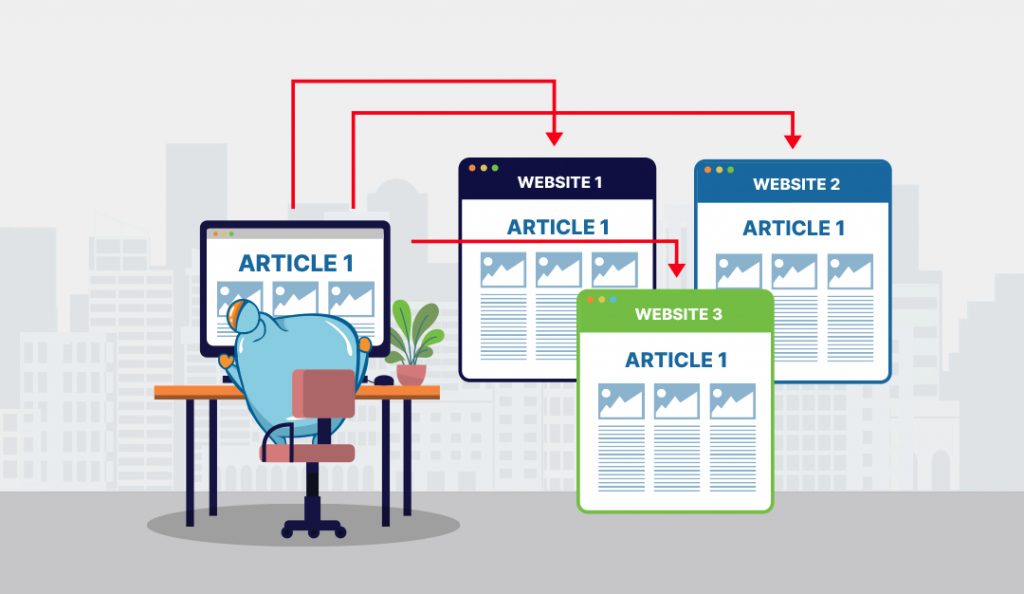
Content syndication is a little bit different for e-Commerce businesses. In this article, we will talk about what content syndication is and what B2C (business to customers) and B2B (business to business) businesses should know when it comes to syndicating content.
We sort of already know what content is, so let’s just consider syndication.
The best example of syndication comes from the news industry. You’ve probably watched a local news channel (for your city, state, region, etc.) and seen a national news item, or a news segment that didn’t originate from your local news agency.
Most likely, what was occurring was some sort of content syndication network: the national news station had its news sent (syndicated) to other, more localized news stations.
Likewise in the content marketing game: a good content distribution plan may involve a particular piece of content, like a blog post, that is syndicated to a third-party website for brand awareness – where it can be seen by more members of its target audience, hopefully reaching more potential customers.
From a search engine perspective, e-Commerce content marketers who use original content as part of a content syndication strategy stand to gain a lot of exposure to a wider audience, more traffic, and SEO performance benefits.
Now that we’ve established that, let’s really get into what this article is about…

I think the biggest thing I can tell you about this is that you (or rather, your content) should meet your prospective buyer where they’re at now.
I’m referring to a concept some may call the buyer’s journey. It may also be referred to as the various stages of product/solution awareness.
I can summarize it in about 10 points:
Although I worded the above steps as using a different person in each one, can you see how a single person can proceed from step 2 to step 10?
That’s the buyer’s journey (or, at least my attempt to describe it).
As we dive into the more mechanical aspects of content syndication, I want you to consider the sites where your republished content will be seen. Then, ask yourself, “What stages of awareness will these viewers, who probably have never heard of us, be at?”
Of course, it may be hard to say that everyone who sees a particular piece of content will be at the same stage in the buyer’s journey. That said, you can have titles and headlines that appeal to people at certain stages.
For example, if you have a solar-powered device, you can syndicate an article or video with the title, “What to Look for in a Solar-Powered ___”
(This is great, because you can get the best return on investment for your digital content.) That said, you may have to spend more for the hours your staff may spend in repurposing and syndicating that content. (I’ll talk about repurposing below.)
Syndication partners and services are other sites that you can partner with (for example, maybe you have a friend who has a site that compliments yours or has relevant content), or you can find paid content syndication networks to distribute your content for you.

You’ve probably heard this saying: don’t work in your business, work on it.
Of course, this means that, for tasks that others can do, you should do just that: get others to do them for you.
Content syndication platforms (or people and tools that can submit to those platforms) are a good place to start freeing up your time so that you can make use of that time to work on your business instead..
In addition to plain, written text, there are a number of content types that you can syndicate. There are a number of content syndication services that can publish syndicated content of different types.
1. Regular, plain-old text syndication platforms might themselves be authoritative websites, and be great for audience engagement and expanding your online presence.
Guest blogging would probably fall under this category.
2. Content syndication platforms that accept infographics and other visual content for syndicated posts, such as images, charts, slides, graphs, and maybe videos, are another type of platform.
3. Some content syndication platforms can syndicate audio content. If you have a podcast, or a how-to on audio, you may wish to include these platforms in your content strategy.
4. Some social media platforms can be used as publishing platforms for content syndication. If your ideal audience are entrepreneurs or big businesses, then LinkedIn can serve as a platform for B2B content syndication and can also serve as a platform for lead generation.
5. If your own website has an RSS feed (which it probably does), there are things you can do to syndicate portions of your content to other sites. Some third-party sites (which probably pull in RSS feeds) probably won’t publish your entire article, but may feature a snippet of it, with a canonical link back to your site. RSS feeds are heavily used among news-based sites.

There are some sites (and tools) that can serve as content syndication partners for you. That is, they can actively distribute your content for you. IFTTT (If This, Then That) tools are an example of this. As with a lot of what I mention here, these tools can be used to ultimately get a lot of referral traffic to your site.
There are other websites that are starving for good content. Of course, you have to assess whether their monthly traffic volume is worthy of your time and if they can provide relevant traffic to your website.
You already know what this is: consider where your reader is (or is likely to be) at this point in their buyer journey.
It’s such an important point that it’s worth stating again.
In fact, it’s what I did when I was titling, planning, and writing this article: there are many articles out there on content syndication, so I wanted to focus on a certain sub-market of readers. I chose you: the e-Commerce business owner.
I then thought of the dynamics of physical product e-Commerce that make your business (whether you’re B2C or B2B) different from that of, say, a purely digital business. (And yes, SaaS is both digital and a form of e-Commerce, so there’s a bit of overlap you can work with.)
Anyway, that’s why I came up with Content Syndication: What e-Commerce Businesses Should Know, because I know that if you’re considering this, you’ll want to know how it can help grow your e-Commerce business.
So, that’s the buyer’s journey in action.

An expert roundup post is what it sounds like: a collection of thoughts, quotes, links, etc. from a number of experts in a given subject area.

Different content syndication platforms may have different rules pertaining to the content you want to syndicate. Also, there are some sites that may not be considered among these platforms, but which you may use for content syndication. With that in mind:
Do you write white papers for your product or industry?
Yup, you guessed it: syndicate it.
After all, you and your company have put a tremendous amount of effort into your content production. The result has been your professional, industry-standard white papers, so why not invest a little bit more? Your content syndication efforts will be well worth it, especially if white papers are the type of content your audience likes to read.
To get consistent traffic, you should consistently syndicate content such as original articles, guest posts, and other blog content.
An original article that’s truly original (in the sense that it has original ideas that can shift people’s perspectives) can also be syndicated, but first, publish it on your site. (In fact, that’s such a key piece of advice that it deserves to stand on its own.)
If you’d like to lower your costs of content production, consider repurposing. Content repurposing, which is a way of reusing or transforming a piece of content, can be a great part of a content syndication campaign. If you’re creative enough, various types of content can be transformed into other types of content.
For example, if you have a video that doesn’t necessarily require that someone visually see the video to learn, then you can publish the audio portion as a podcast episode.
Or, if you have a slide presentation, each slide can be its own image. Or vice versa: a series of sequential images can be put together into a slide presentation.
Content repurposing is a great, low-cost way to get in front of ideal prospects on popular sites.
If you write your own blog content, then B2B content syndication can be a great promotional effort: it helps other sites that need content from experts like you, it can help your site in the search engines (because remember: you linked back to your site), and as a result, it’s a good way to gain organic traffic.
When you syndicate content the way I’ve mentioned in this article, you won’t have to worry about duplicate content penalties. (In fact, in my opinion, there’s no duplicate content penalty per se.)
When you do a lot of content syndication, after a while, you’ll most likely see a growth in traffic.
So, the next question is this: how do you know which content syndication partner sites are working best?
Google Analytics can provide clues. If you don’t yet have it installed on your site, you may wish to install it (or an alternative).

If you’re not sure what they are, Web 2.0 platforms are sites that allow you to have your own site on their domain.
For example, on WordPress.com (not to be confused with WordPress.org), your site might be mysite.wordpress.com
The good thing about this is that, in a way, these sites let you create your own blog that can serve as your own content syndication platform.
The SEO Intelligence Agency (SIA) has done numerous experiments on a wide array of SEO-related topics. One of them is on web 2.o syndication – what type of content to use and which Web 2.0 sites provide SEO benefit. Test 37 of the SIA on Web 2.0 Syndication discusses this. Check out Clint’s video about the test at https://www.youtube.com/watch?v=3BUAOy3Kh3o
When it comes to content syndication, one of the biggest, most important tips I can tell you is this: before you syndicate content, publish to your own site first. (Unless, of course, the sites you’re syndicating to want some sort of exclusivity.)
And then, when you syndicate your content, link to your site, which will have the original post. This helps minimize any supposed “duplicate content” issues, and makes other authoritative sites give your site some domain authority.
That tip is so important it should be considered one of the basics of content syndication.
With that, I hope you now have a better idea of how content syndication can work for e-Commerce businesses, and how each step of the buyer’s journey determines the topic of each piece of content you syndicate.
Have some questions on content you could use for syndication or maybe how to write optimized content that would help you get ranked in Google search results and drive relevant traffic to your site? Or maybe just anything about SEO? Check out our other content on our site for more tips, tricks, and valuable SEO information.
